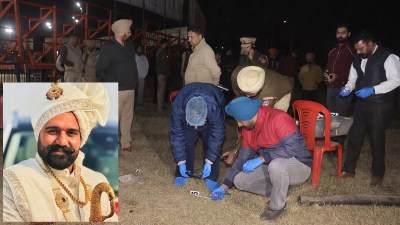Sprinklers continue rounds at monitoring stations amid row over air pollution in Delhi
According to locals from the area, the activity has been ongoing post Diwali
 Sprinklers at Anand Vihar monitoring station (Express/Gajendra Yadav)
Sprinklers at Anand Vihar monitoring station (Express/Gajendra Yadav)Water sprinklers continued to make rounds at regular intervals around Air Quality Monitoring stations on Sunday, even as the city’s air quality remained in the upper range of the poor category.
On Saturday, the Aam Aadmi Party had alleged that water was being sprayed day and night right outside the area where the air for monitoring is sucked in at the Anand Vihar ISBT pollution station “to artificially lower” AQI (air quality index) readings.
The BJP had dismissed the charge as foolish and politically motivated.
At Anand Vihar, water sprinklers were seen circling Anand Vihar ISBT spot at around 1:30 pm, and returning occasionally. The PM levels showed a steep fall from 370 to 197 microgrammes per cubic meter between noon and 3 pm.
According to locals from the area, the activity has been ongoing post Diwali.
At RK Puram, the AQI monitor is placed inside the Kendriya Vidyalaya in Sector 2. The area has a heavy tree cover.
Water sprinklers were seen making multiple rounds at 15-20 minute intervals on the road outside the school, and the road remained wet.
Between 1:00 and 2:30 p.m., both Anand Vihar and R.K. Puram stations show a drop in PM2.5 and PM10 levels, which coincides with the time of water sprinkling nearby. At Anand Vihar, PM2.5 fell from about 180 µg/m³ to around 100 µg/m³, and PM10 from around 500 µg/m³ to below 200 µg/m³. R.K. Puram also saw a similar, though smaller, fall.
 Sprinkling water near Pollution monitoring centre in R K Puram on Sunday (Express/Gajendra Yadav)
Sprinkling water near Pollution monitoring centre in R K Puram on Sunday (Express/Gajendra Yadav)
Experts said that sprinkling increases the moisture content in the air and heavier dust particles settle temporarily.
“Because the monitor is located near one of the exit points at the very crowded Interstate Bus Terminal, instead of capturing ambient air, this station mostly captures key pollutants from road dust and tail pipes,” said an expert about the monitor at Anand Vihar.
Added moisture in the air attaches to particulate matter, making the particles heavier so they settle down, resulting in lower readings at the monitoring site.
“The nearest obstruction shouldn’t be within 20 metres of a monitoring station,” said Sunil Dahiya, leading analyst and founder of Envirocatalysts, a Delhi-based think tank.
However, a gradual fall in pollution levels after noon, is also typical of warmer conditions setting in during the day. Rising temperatures cause vertical air mixing (as warm air rises it lifts the pollution load) and dispersal of pollutants. So, the post-noon decline likely comes from both local cleaning from sprinkling and natural dispersal due to warmer daytime conditions.
Delhi Pollution Control Committee officials did not respond to calls and messages.







